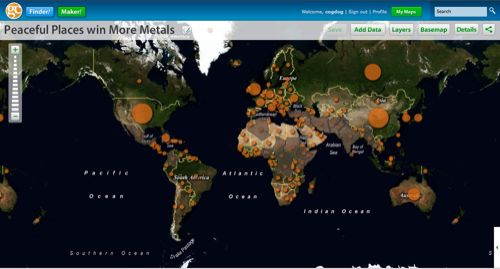Sometimes it can take months to answer a question; Robert, a colleague I met in Shanghai who teaches at Fudan University asked if I knew of any tools that would make it easy for his journalism students to generate their own mashups of data and maps. I did not have an answer then; I talked about being able to easily annotate maps in Google MyMaps (bit this was a manual process) and other ways of connecting data and maps required a bit more technical chops.
Much too late, I do have a better answer now, Geocommons which (sigh, why would any site put a description of their service as a freakin graphic! let me copy paste!):
delivers visual analytics through maps; enabling non-technical professionals to view multiple datasets, draw conclusions, make decisions and solve problems without traditional GIS overhead
More or less, by clicking, you can select from a library of different data sets, and then layer them on a map (There are ways of adding your own data to the Finder).
Some quick examples:
- Prevalence of Bike Commuters in Less Obese States http://maker.geocommons.com/maps/566: So does one cause the other??
- Wait Time At Polls, November 4, 2008 http://maker.geocommons.com/maps/1334: using data from Twitter Vote Report
- Number of Facebook Users in the US http://maker.geocommons.com/maps/83?page=1: Is it for city folk only?
- Freshmen are Criminals http://maker.geocommons.com/maps/352?page=1: Not a conclusion I would make- looks like someone else was playing with data!
I gave it the 20 minute spin this morning, creating a world map that attempts to conclude that countries in violent conflict don’t do well in the Olympics (duh, it is just an experiment):

http://maker.geocommons.com/maps/1475
There was another layer I had tossed in to map cities with the tallest skyscrapers, which was meaningless and made more clutter than interest.
I poked around the sets of data until I found two things that maybe were not directly associated. Data sets can be..data associated with place, but also include things like roadways and geographic boundaries (like school districts, maritime regions). There are display options for the way data is distributed and displayed (colors, circles or squares).
The data is tagged, and you can combine tags and keywords in the searches- the results are a bit tedious in that they are paged 4 at a time. It would also have been nice if once I had made base map on a world scale, if I could filter out data sets that were at a different scale (like crop yields in Iowa). The data is also spotty, in some places there are pages and pages of EPA data, but the geography boundary category only has 2 items. It would also be nice if the results had an embed code.
But this is minor compared to the kinds of things you can create by connecting data and maps, and to visualize relationships. You may not achieve the energy of Hans Rosling, but I see a lot of potential here, be it in learning how to look at data (and then research whether there is a real meaning or just accidental correlation). Or an activity to add your own geodata to the collection.
Mashing up data and maps is so easy a dog can do it!


Thanks for the feedback – very good points. (especially the text as image, that needs to be fixed asap!)
The data is provided by our team as well as the organizations and anyone. So currently it definitely reflects the type of people that have begun using the system and uploading data. Over time, we hope that everyone will contribute their data, as it makes the sharing and use of all this great geospatial data much easier.
We’re working on the embed code – the primary issue is to not make these maps too large when they are embedded in blogs and sites to bog down that site.
Please feel free to provide any other feedback. We’re busy at work on some major features as well as intermediary improvements.
I guess I will have to try Geocommons to see for myself, but I am not understanding the advantage of this over ManyEyes (http://manyeyes.alphaworks.ibm.com/manyeyes/) or the Google visualization API (cf. http://spreadsheets.google.com/pub?key=pCQbetd-CptGXxxQIG7VFIQ) . Is it because the data already exists and has been entered? Anyways, always good to have another one to check out.
@Scott Leslie: I’ve not gone deeper in ManyEyes to know if they mashup data to maps. I think the advantage over the Google API is the lower technical threshold to use the site. Ultimately, what might be beneficial is people sharing more data sets (you know sharing?).
What is missing, I’d like to see is if I fnd your map, I’d like the option to use that as a starting map so I can make own derivative version. That would be cool.
@Scott Leslie – as Alan pointed out, we’re foremost making the system very usable for non-experts to create potentially advanced geospatial maps.
And yes, in the end it’s about sharing data and tools doing what they do best. So being able to share common datasets, as well as outputs themselves – so imagine chaining a GIS Shapefile and Yahoo Pipes to a combined GeoCommons Maker! map to a ManyEyes chart visualization.
Map Cloning is definitely on the “upcoming” 🙂
@alan and @andrew – it’s great to have another tool that can help with this, especially easier to use ones. FYI, I’d suggest ManyEyes is pretty good in this regards (though does have limits on the maps it can easily map against) but concede that using Google’s visualizations aren’t always for the faint of heart (though accessing through their spreadsheets is a real winner).
In any case, no sleight was intended, thanks for pointing to geocommons! And kudos to Andrew and “geocommons” for clearly being on the “cluetrain” – both in their awareness of the need for open map apis/data, but also for participating authenticately in the broader web dialogue. Breath of fresh air.